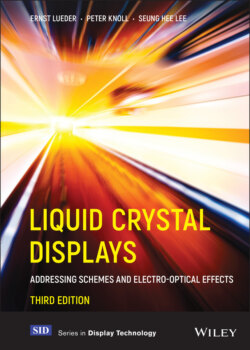Читать книгу Liquid Crystal Displays - Ernst Lueder - Страница 38
4.2.4 Reflective TN cells
ОглавлениеThe basic structure of a reflective cell is depicted in Figure 3.12(a). After the light has passed the polarizer placed at an angle α to the x-axis, it is reflected at the rear mirror. Contrary to the untwisted case, we place the mirror at any distance z, and not only at z = d/2. Then the transmission from the input to the mirror is given by the Jones vectors Osσ and Osτ in
Figure 4.10 The reduced intensity of a mixed mode TN display
Equation (4.51) as
(4.85)
with the transition matrix
(4.86)
The σ–τ coordinates are shown in Figure 4.1 with the twist angle β from the x-axis. The components 0sσ and 0sτ are reflected at a mirror placed at z = d in Figure 4.1. If the mirror is metallic it cannot sustain an electric field. For this reason, an incident elliptically polarized wave in Figure 4.11 generates the electric field shown with dashed lines in Figure 4.11. This field is reflected and propagates in the z-direction towards the input. The dashed field has a phase shift from the incident field. This phase shift is omitted in the future calculation as it is of no importance for the intensity to be calculated. Therefore, neglecting the phase shift caused by the reflection, we assume the vector with the components Osσ and Osτ at z ≠ 0 as the input for a wave travelling in the opposite direction towards the input. The pertinent transmission matrix Tr is, according to the principle of reciprocity in physics (Yeh and Gu, 1999),
Figure 4.11 Incident (—) and reflected (- - -) elliptically polarized light at the metallic mirror of a reflective cell
(4.87)
where T′ stands for the transpose of T. With T′ we obtain
(4.88)
where Osx and Osy are the reflected Jones vectors at the input in the x–y coordinates. To obtain the component passing through the polarizer, we have to rotate the coordinates by α, resulting in
(4.89)
Osξ and Osη are the components in the ξ−η coordinates in Figure 4.1.
Insertion of Equations (4.85) and (4.88) into Equation (4.89) yields
(4.90)
With T from Equation (4.86), we obtain
(4.91)
and with Equation (4.90)
where the abbreviations in Equation (4.91) have been used. The intensity Iξ passing through the polarizer is
or
(4.92)
The intensity perpendicular to the polarizer is
or
(4.93)
An maximum for Iξ dependent on α is reached by d Iξ/d α = 0. This leads to
(4.94)
and for
(4.95)
with
(4.96)
with γ from Equations (4.47) and (4.49) and a from Equations (4.48) and (4.49).
For 2α in Equation (4.95), the term in parentheses in Equation (4.92) vanishes, hence this provides the minimum intensity
(4.97)
whereas 2α in Equation (4.94) yields the maximum intensity
(4.98)
the largest intensity possible.
The minimum intensity in Equation (4.97) becomes zero for
(4.99)
For this value Equation (4.95) provides the pertinent angle α of the polarizer as
(4.100)
which has a solution for a ≥ 1.
From the results for the field-free reflective cell reached so far, we derive the conditions for a normally black cell. We recall that in a reflective cell in Figure 3.12(c), the polarizer and the analyser are identically oriented at an angle α to the x-axis.
The minimum intensity in Equation (4.97) with the angle of the polarizer in Equation (4.100) provides the black state. It can be zero for tan γ in Equation (4.99), that is for
(4.101)
providing
(4.102)
Equation (4.101) must be solved numerically. A table of solutions can be found in Yeh and Gu (1999).
Two examples are:
Once a in Equation (4.101) has been found, Δnd/λ and α can be calculated from Equations (4.96) and (4.102). The black state is achieved only for a given λ, which determines d in Equation (4.96); λ = 550 nm and Δn = 0.05 yield d = 3.19 μm in the first case and d = 18.26 μm in the second case in the table above.
The solutions for normally black reflective cells with α ≠ 0 discussed so far belong to the mixed mode TN cells introduced in Section 4.2.3. For α = 0 Equation (4.81) requires a = l, and from Equation (4.99) tan γ = ∞ or leading to a twist angle . The regular TN cell with β = π/2 does not permit a solution for a reflective cell with Iξ = 0 at a given wavelength λ. Therefore, mixed mode TN cells are preferred for reflective TN displays.
As normally white reflective TN cells are seldom used due to their poorer performance, they are not dealt with here. A description can be found in Yeh and Gu (1999).
